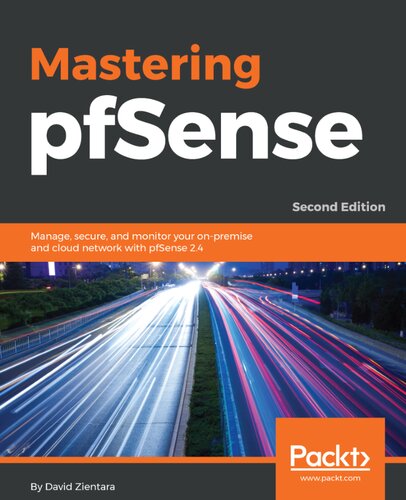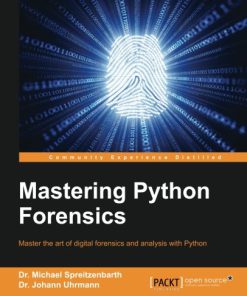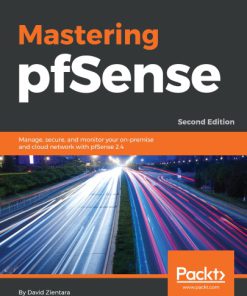MASTERING PFSENSE master the art of managing securing and monitoring your on premises and cloud network using the powerful pfsense 2 4 3 2nd edition by Zientara ISBN 1788993470 9781788993173
$50.00 Original price was: $50.00.$25.00Current price is: $25.00.
MASTERING PFSENSE master the art of managing securing and monitoring your on premises and cloud network using the powerful pfsense 2 4 3 2nd edition by Zientara – Ebook Instant Download/Delivery ISBN:1788993470,9781788993173

Product details:
Install and configure a pfSense router/firewall, and become a pfSense expert in the process.
About This Book
- You can always do more to secure your software – so extend and customize your pfSense firewall
- Build a high availability security system that’s fault-tolerant – and capable of blocking potential threats
- Put the principles of better security into practice by implementing examples provided in the text
Who This Book Is For
This book is for those with at least an intermediate understanding of networking. Prior knowledge of pfSense would be helpful but is not required.
Those who have the resources to set up a pfSense firewall, either in a real or virtual environment, will especially benefit, as they will be able to follow along with the examples in the book.
What You Will Learn
- Configure pfSense services such as DHCP, Dynamic DNS, captive portal, DNS, NTP and SNMP
- Set up a managed switch to work with VLANs
- Use pfSense to allow, block and deny traffic, and to implement Network Address Translation (NAT)
- Make use of the traffic shaper to lower and raise the priority of certain types of traffic
- Set up and connect to a VPN tunnel with pfSense
- Incorporate redundancy and high availability by utilizing load balancing and the Common Address Redundancy Protocol (CARP)
- Explore diagnostic tools in pfSense to solve network problems
In Detail
pfSense has the same reliability and stability as even the most popular commercial firewall offerings on the market – but, like the very best open-source software, it doesn’t limit you.
You’re in control – you can exploit and customize pfSense around your security needs.
Mastering pfSense – Second Edition, covers features that have long been part of pfSense such as captive portal, VLANs, traffic shaping, VPNs, load balancing, Common Address Redundancy Protocol (CARP), multi-WAN, and routing. It also covers features that have been added with the release of 2.4, such as support for ZFS partitions and OpenVPN 2.4. This book takes into account the fact that, in order to support increased cryptographic loads, pfSense version 2.5 will require a CPU that supports AES-NI.
The second edition of this book places more of an emphasis on the practical side of utilizing pfSense than the previous edition, and, as a result, more examples are provided which show in step-by-step fashion how to implement many features.
Style and approach
Practical guide to learn the advanced functionalities of pfSense with minimum fuss.
Table of contents:
Packt Upsell
Why subscribe?
PacktPub.com
Contributors
About the author
About the reviewer
Packt is searching for authors like you
Preface
Who this book is for
What this book covers
To get the most out of this book
Download the color images
Conventions used
Get in touch
Reviews
Revisiting pfSense Basics
Technical requirements
pfSense project overview
Possible deployment scenarios
Hardware requirements and sizing guidelines
Minimum hardware requirements
Hardware sizing guidelines
The best practices for installation and configuration
pfSense configuration
Configuration from the console
Configuration from the web GUI
Configuring additional interfaces
Additional WAN configuration
General setup options
Summary
Questions
Further reading
Advanced pfSense Configuration
Technical requirements
SSH login
DHCP
DHCP configuration at the console
DHCP configuration in the web GUI
DHCPv6 configuration in the web GUI
DHCP and DHCPv6 relay
DHCP and DHCPv6 leases
DNS
DNS resolver
General Settings
Enable DNSSEC support
Host Overrides and Domain Overrides
Access Lists
DNS forwarder
DNS firewall rules
DDNS
DDNS updating
RFC 2136 updating
Troubleshooting DDNS
Captive portal
Implementing captive portal
User manager authentication
Voucher authentication
RADIUS authentication
Other settings
Troubleshooting captive portal
NTP
SNMP
Summary
Questions
VLANs
Technical requirements
Basic VLAN concepts
Example 1 – developers and engineering
Example 2 – IoT network
Hardware, configuration, and security considerations
VLAN configuration at the console
VLAN configuration in the web GUI
QinQ
Link aggregation
Add firewall rules for VLANs
Configuration at the switch
VLAN configuration example 1 – TL-SG108E
VLAN configuration example 2 – Cisco switches
Static VLAN creation
Dynamic Trunking Protocol
VLAN Trunking Protocol
Troubleshooting VLANs
General troubleshooting tips
Verifying switch configuration
Verifying pfSense configuration
Summary
Questions
Using pfSense as a Firewall
Technical requirements
An example network
Firewall fundamentals
Firewall best practices
Best practices for ingress filtering
Best practices for egress filtering
Creating and editing firewall rules
Floating rules
Example rules
Example 1 – block a website
Example 2 – block all traffic from other networks
Example 3 – the default allow rule
Scheduling
An example schedule entry
Aliases
Creating aliases from a DNS lookup
Bulk import
Virtual IPs
Troubleshooting firewall rules
Summary
Questions
Network Address Translation
Technical requirements
NAT essentials
Outbound NAT
Example – filtering outbound NAT for a single network
1:1 NAT
Example – mapping a file server
Port forwarding
Example 1 – setting up DCC
Example 2 – excluding a port
Example 3 – setting up a personal web server
Network Prefix Translation
Example – mapping an IPv6 network
Troubleshooting
Summary
Questions
Traffic Shaping
Technical requirements
Traffic shaping essentials
Queuing policies
Priority queuing
Class-based queuing
Hierarchical Fair Service Curve
Configuring traffic shaping in pfSense
The Multiple LAN/WAN Configuration wizard
The Dedicated Links wizard
Advanced traffic shaping configuration
Changes to queues
Limiters
Layer 7 traffic shaping
Adding and changing traffic shaping rules
Example 1 – modifying the penalty box
Example 2 – prioritizing EchoLink
Traffic shaping examples
Example 1 – adding limiters
Example 2 – penalizing peer-to-peer traffic
Using Snort for traffic shaping
Installing and configuring Snort
Troubleshooting traffic shaping
Summary
Questions
Further reading
Virtual Private Networks
Technical requirements
VPN fundamentals
IPsec
L2TP
OpenVPN
AES-NI
Choosing a VPN protocol
Configuring a VPN tunnel
IPsec
IPsec peer/server configuration
IPsec mobile client configuration
Example 1 – Site-to-site IPsec configuration
Example 2 – IPsec tunnel for remote access
L2TP
OpenVPN
OpenVPN server configuration
OpenVPN client configuration
Client-specific overrides
Server configuration with the wizard
OpenVPN Client Export Utility
Example – site-to-site OpenVPN configuration
Troubleshooting
Summary
Questions
Redundancy and High Availability
Technical requirements
Basic concepts
Server load balancing
Example – load balancer for a web server
HAProxy – a brief overview
CARP configuration
Example 1 – CARP with two firewalls
Example 2 – CARP with N firewalls
An example of both load balancing and CARP
Troubleshooting
Summary
Questions
Further reading
Multiple WANs
Technical requirements
Basic concepts
Service Level Agreement
Multi-WAN configuration
DNS considerations
NAT considerations
Third-party packages
Example – multi-WAN and CARP
Troubleshooting
Summary
Questions
Routing and Bridging
Technical requirements
Basic concepts
Bridging
Routing
Routing
Static routes
Public IP addresses behind a firewall
Dynamic routing
RIP
OpenBGPD
Quagga OSPF
FRRouting
Policy-based routing
Bridging
Bridging interfaces
Special issues
Bridging example
Troubleshooting
Summary
Questions
Extending pfSense with Packages
Technical requirements
Basic considerations
Installing packages
Important packages
Squid
Issues with Squid
Squid reverse proxy server
pfBlockerNG
ntopng
Nmap
HAProxy
Example – load balancing a web server
Other packages
Snort
Example – using Snort to block social media sites
FRRouting
Zabbix
Summary
Questions
Further reading
Diagnostics and Troubleshooting
Technical requirements
Troubleshooting basics
Common networking problems
Wrong subnet mask or gateway
Wrong DNS configuration
Duplicate IP addresses
Network loops
Routing issues
Port configuration
Black holes
Physical issues
Wireless issues
RADIUS issues
pfSense troubleshooting tools
System logs
Dashboard
Interfaces
Services
Monitoring
Traffic graphs
Firewall states
States
States summary
pfTop
tcpdump
tcpflow
ping, traceroute and netstat
ping
traceroute
netstat
Troubleshooting scenarios
VLAN configuration problem
Summary
Questions
Assessments
Chapter 1 – Revisiting pfSense Basics
Chapter 2 – Advanced pfSense Configuration
Chapter 3 – VLANs
Chapter 4 – Using pfSense as a Firewall
Chapter 5 – Network Address Translation
Chapter 6 – Traffic Shaping
Chapter 7 – Virtual Private Networks
Chapter 8 – Redundancy and High Availability
Chapter 9 – Multiple WANs
Chapter 10 – Routing and Bridging
Chapter 11 – Extending pfSense with Packages
Chapter 12 – Diagnostics and Troubleshooting
People also search:
the pfsense firewall is a border firewall
pfsense management port
understanding pfsense firewall rules
using pfsense as a firewall
mastering pfsense
You may also like…
Computers - Programming
Computers - Web Development
CSS Animation Master the Art of Moving Objects on the Web 1st Edition Parmar
Computers - Networking
Computers - Networking
Computers - Computer Graphics & Design
Computers - Networking












